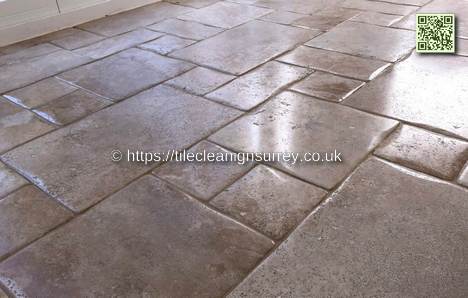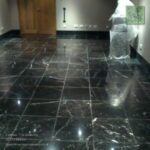This case study showcases the restoration of travertine tiles in high-traffic areas of a property in Chessington, Surrey. As the years passed, the once-beautiful travertine had lost its luster, becoming dull, stained, and worn. To restore its original elegance, we undertook a comprehensive project that included deep cleaning, filling natural holes, and applying a protective sealant. The result was a beautifully revitalized, low-maintenance floor that regained its natural charm and received long-lasting protection for future durability.
Travertine Floor Cleaning In Chessington – Key Points
- Thorough Cleaning is Crucial: A rotary scrubbing machine, heavy-duty travertine cleaners, and hot water pressurized rinse equipment remove ingrained soil that regular mopping can’t tackle.
- Filling Holes Enhances Appearance and Durability: Addressing natural holes in the travertine improves its look and prevents future damage, ensuring the stone’s longevity.
- Sealing Simplifies Maintenance: A properly applied sealer acts as a protective barrier, making future cleaning easier and preventing stains from setting in.
- Consistent Maintenance is Essential: A regular maintenance routine, including periodic resealing, keeps the travertine pristine and preserves its beauty for years.
Client Background:
This project focused on restoring travertine tiles in a Chessington home, where the kitchen, hallway, and w/c floors had suffered significant wear over the years. The homeowner sought a solution to bring back the natural beauty of the travertine while ensuring the floors would be easy to maintain and durable enough to withstand daily use. The restoration process involved deep cleaning, filling natural holes, and applying a protective sealant to achieve a clean, resilient surface that highlights the rich colors of the travertine.
 Project Background:
Project Background:
The travertine tiles, admired for their natural beauty and durability, had been in place for over a decade. Over time, the tiles lost their smooth finish, with soil accumulating in the pits and voids. The grout was discoloured, diminishing the floor’s overall look. The project involved deep cleaning the tiles, filling the natural holes, and applying a protective sealer to restore the floor’s appearance and enhance its long-term resilience.
Challenges Encountered During the Project
- Deeply Embedded Dirt: Years of foot traffic had caused dirt to become ingrained in the natural pits and voids of the travertine, making it difficult to clean with standard methods.
- Natural Holes: Travertine tiles’ inherent holes and gaps trap the dirt and add to the floor’s worn appearance.
- Stained Grout: Over time, the grout between the tiles had become heavily stained, further diminishing the floor’s visual appeal.
- High Traffic Areas: The constant use of these spaces required a restoration approach that effectively revitalized the floor while minimizing disruption to the household.
Solution and Process:
Step 1: Assessment and Planning
The initial assessment identified the level of soiling and wear on the travertine tiles. Based on these findings, a plan was crafted to remove the ingrained dirt, fill the natural holes, and apply a protective sealer to restore the tiles and improve their durability.
Step 2: Cleaning Process
We prepared the work area by removing small pieces of furniture and clearing loose debris with brushing and vacuuming. After applying a diluted travertine cleaner and letting it soak for ten minutes, we used a rotary scrubbing machine with a medium-grade brush to remove the surface soil. We used hot-water rinse and capture equipment to tackle the dirt trapped in the holes and pits, effectively lifting the remaining soils and restoring the travertine’s clean surface.
Step 3: Filling Natural Holes
Step 4: Sealing the Floor
We applied a hybrid satin finish sealer with a roller, creating a mid-sheen look. This sealant formed a protective barrier against stains and dirt, making the floor easier to maintain. We ensured full coverage and a consistent finish during the sealing process.
Project Timeline:
We completed the project in two days, from assessment to final touches.
Project Results:
We restored the travertine to its original finish by removing ingrained soil and stains, revealing the natural colours of the tiles. The client expressed her delight with the results, commenting that the floor “looked as good as new”. The protective sealer now keeps the travertine low-maintenance and durable, preserving its beauty and functionality for the long term. This project turned a dull, worn floor into a revitalized, stunning surface.
Conclusion:
This travertine cleaning project in Chessington restored the tiles’ natural beauty, making them a durable and low-maintenance flooring solution for the homeowner. We significantly enhanced the floor’s appearance and extended its longevity through deep cleaning, precise filling, and effective sealing. This case study highlights the value of professional cleaning and maintenance for natural stone surfaces like travertine.
If your travertine floor needs cleaning or restoration, contact us today for a consultation. Our expert services will keep your natural stone surfaces beautiful and functional for years to come.
Frequently Asked Questions
How Long Does the Travertine Cleaning Process Take?
The travertine cleaning usually takes several hours, depending on the floor’s condition. Thorough cleaning techniques remove ingrained soil and prepare the tiles for sealing, which helps prolong their lifespan.
Is It Safe to Use DIY Cleaning Products on Travertine?
Homemade cleaning solutions on travertine can be risky due to potential chemical reactions that may harm the stone. For this reason, it’s safer to use pH-balanced cleaners specifically designed for natural stone to ensure effective and safe cleaning.
Can Travertine Floors Be Installed Over Existing Tile?
Yes, travertine floors can be installed over existing tiles. Proper installation requires assessing the underlying surface and potentially levelling it to ensure a stable, long-lasting finish.
What Is the Cost Range for Travertine Floor Cleaning Services?
The cost of travertine floor cleaning services typically ranges from £3 to £5 per square foot. The price varies depending on the cleaning methods, soiling, and the condition of the tiles.
How Often Should Travertine Floors Be Professionally Cleaned?
Travertine floors should be professionally cleaned every 12 to 18 months. Regular maintenance, including prompt spill management and periodic sealing, will help preserve the stone’s natural beauty and longevity.
The post Travertine Floor Cleaning In Chessington Surrey. Sponsored by: Travertine Cleaning Chessington
The Article Reviving Travertine Floors in Chessington, Surrey appeared first on https://fabritec.org
The Article Reviving Travertine Floors in Chessington, Surrey Was Found On https://limitsofstrategy.com


While the detailed approach to restoring the travertine tiles in Chessington certainly highlights an impressive transformation, it raises questions about the broader implications of such restoration efforts. The article rightly emphasizes the importance of thorough cleaning and sealing; however, it glosses over the fact that reliance on regular maintenance and restoration can be misleading for property owners who may underestimate the investment in time and resources required for long-term upkeep.
You raise a solid point, and it’s true that restoring travertine can feel like a never-ending relationship with a demanding partner. You know, the kind that looks stunning at first but needs constant attention—and possibly a rabid cleaning session every few years to keep the spark alive.
You’ve captured that relationship analogy perfectly. Restoring travertine can definitely feel like an ongoing commitment. I remember when I first installed some in my home; it really did transform the space into something vibrant and warm. However, as years went by, I found myself on this cyclical journey of cleaning, sealing, and sometimes even wishing I had opted for something a little less demanding.
I get where you’re coming from. That initial wow factor of travertine can really set the mood in a space, can’t it? It’s like adding a warm hug to your home. But yeah, that commitment to keeping it looking good can feel like a never-ending chore sometimes.
It’s interesting how materials like travertine can evoke such strong feelings about space and commitment. When I first laid down some nice natural stone in my kitchen, I felt a similar transformation. There’s something about the look and feel of stone that adds a kind of grounding presence to a home. But you’re right; with time, the upkeep can almost feel like a second job.
It’s fascinating how materials like travertine can really set the tone of a space, isn’t it? When I was renovating my own kitchen, I remember the moment I walked into a showroom and felt that immediate connection to the natural stone. It’s amazing how something as simple as a surface can create a sense of warmth and permanence.
It really is interesting how materials like travertine have that unique ability to transform a space. When I was working on my own home, I spent a lot of time exploring different stone options too. There’s something about natural materials that can convey such a sense of history and connection to the earth, isn’t there? It’s like every piece of stone has its own story and brings a kind of permanence to our spaces.
I completely agree with you about the magic natural materials bring to a space. With travertine, it’s fascinating how each piece can vary in color and texture, telling its own story while still fitting into the broader narrative of a home. When I was working on my projects, I found myself drawn not just to the aesthetics, but also to how different stones feel underfoot or how they interact with light.
It’s interesting how personal experiences with travertine can shape our feelings towards it over time. I can relate to the allure of that initial transformation; there’s something inherently satisfying about bringing warmth and vibrancy into a space. When you invest in something like travertine, the hope is that it will remain stunning for years to come.
It’s interesting how home décor can echo the complexities of relationships—there’s so much commitment involved in both. Your experience with travertine resonates with many homeowners, I think. The initial joy of a beautiful installation can often shift over time as you realize the upkeep it requires. I’ve heard from friends who felt the same with natural stone. They adore how it looks but find themselves budgeting weekend time for maintenance.
You’ve hit on something really profound with that connection between home décor and relationships. There’s definitely a commitment involved—the choices we make often reflect our personalities and how we want to express ourselves, just like in relationships where we invest time and effort. Your mention of travertine brings back memories of when I first installed it in my home. The beauty was undeniable—the way it transformed the space was breathtaking. But, yes, the upkeep is a whole other story.
It’s so true how home décor reflects our experiences in relationships. When we first install something like travertine, the excitement can feel a lot like the joy of a new love. But as you mentioned, that joy can fade a bit when you dig into the reality of upkeep.
Restoring travertine does have that unique charm, doesn’t it? It’s almost like a relationship with a lot of maintenance—it can be rewarding, but there are moments when you question the effort. I can relate to your experience of watching that vibrant space become a bit more demanding over the years. Sometimes, I think about how people gravitate toward natural materials like travertine because they evoke a sense of connection to the earth and history.
That’s an interesting way to put it—the comparison to a demanding partner really resonates. I guess it’s all about finding that balance between investment and reward. Travertine, with its natural beauty, can elevate a space, but as you said, it requires a level of dedication to keep it looking its best.
You’ve hit the nail on the head with that analogy. It really shows how our spaces and their materials can reflect a kind of relationship. Travertine indeed has this inherent charm – it’s like a piece of art pulled straight from nature. It has character and depth that very few materials can match. But with that charm comes responsibility, right?
It really is about that balance, isn’t it? I think the analogy of travertine being like a demanding partner is spot on. It reminds me of how many aspects of our lives require that same kind of investment, whether it’s home decor or even personal relationships. When you put in the effort, the rewards can be significant, but it’s not always easy to keep everything maintained.
I completely relate to that idea of a demanding partner when it comes to materials like travertine. It’s almost like a relationship where you have to nurture it to truly appreciate its beauty. The investment in time and effort can feel daunting sometimes, especially with busy lifestyles.
It’s great to see your thoughts on the restoration of the travertine tiles in Chessington. You raise an important point about the implications of restoration efforts and the commitment they demand from property owners. It’s easy to focus on the visual transformation without fully grasping the rigorous ongoing maintenance it requires.
You bring up a really important point about the long-term commitment that comes with maintaining beautiful travertine tiles. It’s easy to focus on the stunning transformation and the initial cleaning, but the ongoing upkeep is where many property owners can feel overwhelmed.
You’re right; the long-term upkeep of travertine tiles can definitely feel daunting at times. I remember when I first installed some in my home, I was so caught up in how great they looked that I didn’t really think about the regular maintenance they’d require. It’s one thing to scrub them clean initially, but that consistent care is what keeps them looking stunning.
You raise some really important points that often don’t get enough attention in discussions about restoration projects like the one in Chessington. The transformation of those travertine tiles, while visually stunning, does indeed come with a hefty dose of responsibility for ongoing maintenance. It’s easy to get taken in by the immediate aesthetic benefits and forget that these materials need continuous care to keep looking their best.
I really appreciate the detailed approach you took with the travertine restoration! It’s fascinating how something that seems so permanent can lose its charm over time. I’ve been thinking about how much our environments affect our mood and overall well-being. A beautiful floor can truly transform a space!
You’ve hit on something really interesting about our environments and their impact on how we feel day to day. It’s amazing how a well-maintained floor, like travertine, can bring a space to life. The right flooring not only adds aesthetic appeal but also influences the light and ambiance of a room.
I completely agree with you. The influence of our environments on our mental and emotional well-being is profound. I’ve noticed that certain materials really do change the feel of a space. For me, natural stone like travertine has this warm, earthy vibe that feels both grounding and uplifting. It’s interesting how something as simple as flooring can dictate not just aesthetics, but also our mood and productivity.
I completely resonate with your thoughts on how our environments impact our mental and emotional well-being. It’s fascinating to consider how specific materials like travertine can create such an intimate atmosphere. I’ve found that the tactile nature of natural elements really has a way of connecting me to the environment around me.
I completely agree with you; the state of our surroundings can have such a significant impact on how we feel. It’s remarkable how something like travertine, which carries so much history, can transform with just a bit of care and attention. I’ve often found that looking down at a beautiful floor can set a tone for the entire room—it’s such an underrated aspect of design.
You’re spot on about the impact of our surroundings on our mood. It’s amazing how something as simple as a well-maintained floor can elevate the entire atmosphere of a space. Travertine, with its rich textures and colors, really does tell a story—each mark and vein reflecting time and care.
You make such a good point about how our surroundings can shape our feelings. It’s amazing how something as simple as a well-kept floor can change the vibe of a room. Travertine, with its unique texture and warmth, does bring a certain energy to a space.
It’s fascinating to see the transformation of travertine tiles through such a comprehensive restoration process. Living in an area with a lot of foot traffic, I’ve often wondered how to maintain natural stone surfaces effectively. The emphasis on thorough cleaning and sealing really highlights how important it is to invest in quality maintenance for longevity.
It’s great to hear you found the restoration process interesting. Living in a busy area, I get why maintaining natural stone surfaces can feel like quite the task. Those high foot traffic zones really take a toll on materials like travertine.